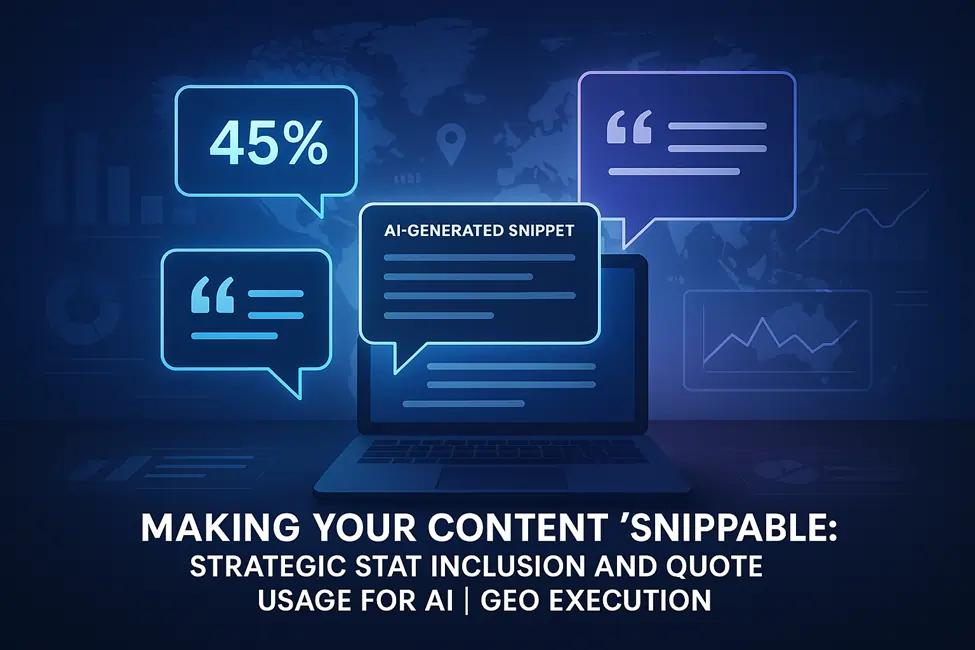Making Your Content "Snippable": Strategic Stat Inclusion and Quote Usage for AI | GEO Execution

The world of search is changing right under our feet. For years, the goal was simple: get to the number one spot on Google. But today, that’s not enough. With the rise of Google’s AI Overviews, the new goal isn't just to be the first link someone clicks; it's to be the answer itself.
This is a massive shift. AI now sits at the very top of the search results, giving users direct, conversational answers. For businesses in India, this isn't just a small update; it's a process. The game has moved from chasing clicks to owning the conversation. Your content now needs to be "snippable" easily understood, extracted, and cited by AI.
At Public Media Solution, we believe in delivering unmatched supremacy in this new digital landscape. This blog is your blueprint to dominate the AI-driven search era. We'll show you how to strategically use statistics and expert quotes to build unbreakable authority and how to apply these techniques with hyper-local precision to win the Indian market.
The New Search Battlefield: Understanding AI Overviews in India
So, what exactly are these AI Overviews? Think of them as an intelligent summary that appears at the top of your Google search results. Instead of just giving you a list of links, Google's AI reads the top-ranking pages and creates a direct, easy-to-read answer, complete with links to its sources.
This AI-generated answer takes up the most valuable space on the page, pushing everything else including the old number one spot—further down. This new top spot is what we call "Position Zero." Getting your brand featured here is the new ultimate prize in SEO.
Why This Matters More in India
This change is significant for the Indian market for three key reasons:
- We are a Mobile-First Nation: A staggering 96% of India's 751.5 million internet users get online using their mobile phones. AI Overviews are perfect for mobile screens, giving quick answers without needing to click through multiple websites.
- The Rise of Voice Search: Voice search in India has grown by an incredible 270%. People are asking questions to their phones and smart speakers, and these devices read out answers directly from AI Overviews. If your content isn't snippable, it's invisible to voice search.
- Linguistic Diversity: An overwhelming 98% of Indian internet users prefer content in Indic languages. AI is being built to understand and answer in these languages, creating a massive opportunity for businesses that create quality, local-language content.
How to Make Your Content "Snippable" for AI
To get your content featured by AI, you need to make it incredibly easy for machines to understand and extract information. Here’s how.
Start with the Answer: The Inverted Pyramid Strategy
This is the golden rule of snippable content. Answer the user's central inquiry immediately, right in the first few sentences. This direct answer should be clear, concise, and ideally between 40 to 60 words.
For example, if you’re writing a blog post on "What is Local SEO?" Your first paragraph should start with: "Local SEO is the method of optimizing your online company to attract more industry from relevant local searches..." After you’ve given the direct answer, you can then go into more detail, add context, and provide supporting information. This structure makes it simple for AI to grab the most essential info for its summary.
Structure for Success: Formatting AI Loves
AI doesn't just read your content; it scans its structure to understand what’s important. Use clean formatting to make your content easy to process.
- Use Lists and Tables: Google’s AI loves bullet points, numbered lists, and tables. They are perfect for breaking down steps, features, or data in a way that’s easy to scan.
- Clear Headings (H1, H2, H3): Organize your content with a logical hierarchy of headings. Your main title should be an H1, with sub-topics under H2s and H3s.
- Frame Headings as Questions: A potent trick is to write your subheadings as questions that your audience is potential to ask, like "How Can Local SEO Help My Business?" or "What are the Best SEO Tools?". This directly matches your content to user queries.
Choose the Right Format for the Query
Different types of searches require different content formats. Align your range with what the user is looking for.
- FAQs: Create dedicated FAQ pages or sections within your articles. Each question-and-answer pair is a perfect target for a specific long-tail search query.
- How-To Guides: For "how-to" questions, structure your content as a step-by-step guide utilizing a numbered list.
- Definitions: For "what is" queries, provide a clear, dictionary-style definition right at the beginning.
Build Unshakeable Credibility with Strategic Statistics
In the world of SEO, trust is everything. Google uses a concept called E-E-A-T (Experience, Expertise, Authoritativeness, and Trustworthiness) to judge the quality of your content. One of the most powerful ways to demonstrate E-E-A-T is by using credible statistics.
Why Data is the Ultimate Trust Signal for E-E-A-T
When you back up your claims with verifiable data, you show both users and search engines that your content is well-researched and factual, not just an opinion. AI systems are designed to prioritize facts, so a page with clear, sourced data is a much more reliable source for building an AI Overview.
Best Practices for Using Stats in the Indian Context
To build trust, your data needs to be relevant and from a reputable source.
- Source Locally: Use data from authoritative Indian bodies like the Telecom Regulatory Authority of India (TRAI), the Press Information Bureau (PIB), or the Internet and Mobile Association of India (IAMAI).
- Always Attribute Your Source: Never just drop a number without saying where it came from. For example, write "According to a 2024 report from Datareportal, India has 751.5 million internet users...". This simple act of citation builds immense trust.
- Explain the "Why": Don't just state a fact; explain why it matters to your reader. For example, the fact that India has over 954 million internet subscribers isn't just a number—it's a massive market opportunity for businesses.
Amplify Your Authority with Expert Quotes
Another powerful way to increase your E-E-A-T is by featuring quotes from recognized industry leaders. When you include an expert's voice, you lend their authority to your own content.
Borrowing Brilliance: The SEO Power of a Good Quote
Quotes act as social proof. They show that your ideas are aligned with the thinking of established experts, which increases trust. Strategically using quotes can even increase your content's visibility in AI-generated answers by up to 40%.
How to Weave Quotes into Your Content
To make your quotes effective, they need to be integrated appropriately.
- Use Relevant Indian Voices: For the Indian market, quote Indian leaders. For instance, to highlight the shift in search behaviour, you could use this powerful insight from Anuraj Gupta, Chief Growth Officer at LS Digital:
- "The traditional processes, from keyword and clicked ad to conversion, are now shifting to conversation-first experiences, where more than 60 per cent of searches end without any clicks".
- Provide Full Attribution: Always mention the person's full name, title, and company.
- Format Correctly: Use the <blockquote> HTML tag to make your quotes stand out visually and signal to search engines that it is a quotation.
- Add Context: Introduce the quote by explaining why it's relevant, and follow up by discussing its implications for your reader.
Winning Locally: Mastering GEO Execution in India
For most businesses in India, customers are local. "Near me" searches have become second nature for Indian consumers looking for everything from a restaurant to a doctor. Mastering local SEO, or GEO Execution, is therefore critical.
The "Near Me" Revolution in the Indian Market
Success in local search means getting into Google's "Local Pack" the map and three business listings that appear at the top for local queries. This is heavily influenced by your Google Business Profile (GBP) and the relevance of your content to a specific location.
Hyper-Local Strategies that Actually Work
- Your Google Business Profile is Your Digital Front Door: This is the foundation of all local SEO. Ensure your profile is 100% complete and accurate—name, address, phone number, business hours, and services. Regularly upload high-quality photos and actively encourage and respond to all customer reviews.
- Create Unique Location Pages (Geo-Hubs): If you have multiple locations, don't just create one page and swap out the city name. This is a "doorway page" and Google can penalize you for it. Instead, create unique, valuable content for each location. Include local testimonials, mention nearby landmarks, talk about local events, and use photos of your local team.
- Speak the Local Language: Your keyword analysis must include local terms. This means city names, neighbourhoods, and even common Hinglish phrases like "sasta AC repair Delhi" that real people use to search. For example, a Delhi café could create content around Diwali celebrations in the city, while a Chennai boutique could write a blog post about shopping trends near T. Nagar.
Your Blueprint for Success with Public Media Solution
The age of AI search is here, and the rules have changed. Success is no longer about just being on the list; it's about being the definitive answer.
By creating "snippable" content that is structured for AI, building credibility with strategic stats and quotes, and mastering hyper-local execution, your brand can dominate this new frontier. This is the exact data-driven, results-oriented approach we take at Public Media Solution to deliver unmatched supremacy for our clients.
Share
Table Of Contents
- The New Search Battlefield: Understanding AI Overviews in India
- How to Make Your Content "Snippable" for AI
- Build Unshakeable Credibility with Strategic Statistics
- Amplify Your Authority with Expert Quotes
- Winning Locally: Mastering GEO Execution in India
- Your Blueprint for Success with Public Media Solution
